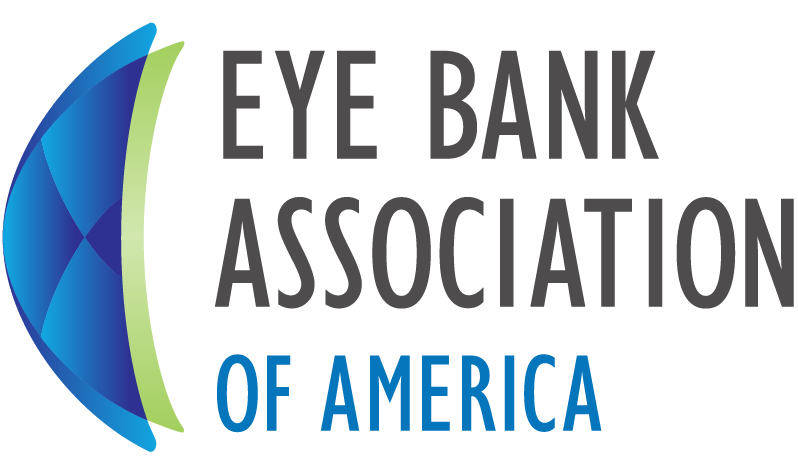About Corneas and Common Diseases
What is the cornea?
The cornea is the eye’s outermost layer, the clear, dome-shaped surface that covers the front of the eye.
What is corneal blindness?
When the cornea becomes cloudy or scarred, light cannot penetrate the eye to reach the light-sensitive retina. Poor vision or blindness may result.
About Transplantation
Is the whole eye transplanted?
No – only the corneas can be transplanted. However, the entire eye may be recovered for use in research or education.
How prevalent is corneal transplantation?
EBAA member eye banks in the U.S. provided 50,925 corneas for transplant within the United States in 2023. Since 1961, more than 2 million men, women, and children worldwide have had their sight restored through corneal transplantation.
While EBAA members are able to fulfill all of the demand for corneas in the U.S., they also provide corneas for use internationally, as there are 12 million cornea-blind individuals worldwide.
How successful is corneal transplantation?
Over 97% of all corneal transplant operations successfully restore the corneal recipient’s vision.
About Donation
Why should eyes be donated?
There is no substitute for human tissue. The transplantation process depends upon the priceless gift of corneal donation from one human to another. Donated eyes are also needed for research and education.
Who can be a donor?
Anyone can. The great thing about corneal tissue is that everyone is a universal donor. Your blood type does not have to match. It doesn’t matter how old you are, what color your eyes are or how good your eyesight is. Aside from those suffering from infections or a few highly communicable diseases such as HIV or hepatitis, most people are suitable donors.
Will the quality of medical treatment be affected if one is a known donor?
No. Strict laws protect potential donors from any form of medical rationing or discrimination. The physician certifying a patient’s death is not involved with the eye procurement or with the transplant, and legal guidelines must be followed before death can be certified.
Will the recipient be told who donated the corneas?
The gift of sight is made anonymously. Specific information about the donor family is not made available to the recipient. If they wish, recipients can write anonymously to their donor family, by way of the eye bank, to express their thanks. The eye bank will pass along this communication.
If a person has already signed a donor card, a driver’s license, or signed a registry, how can they be sure that their wishes regarding donation will be respected?
Tell your next of kin. Talk to your family or guardian about donation, and make sure they know your decision to donate. Next-of-kin cooperation with a medical/social history interview is required before transplantation, so it is helpful if your family and friends know how you feel about donation.
Are there religious objections to eye, organ, or tissue donations?
No. Eye, organ, and tissue donation are consistent with the beliefs of major religions. Donation is an opportunity to help save a life or restore someone’s sight. Include your spiritual leader in your decision-making process.
Is there a fee charged for this donation?
No. It is illegal to buy or sell human eyes, organs and tissue. Any costs associated with cornea recovery and preparation are absorbed by the eye bank placing the tissue.
Is there any delay in funeral arrangements?
No. Eye tissue procurement is performed within hours of death. Families may proceed with funeral arrangements without delay or interruption.
Will eye donation affect the appearance of the donor?
No. Great care is taken to preserve the donor’s appearance. The donor’s body is treated with respect at all times. Funeral arrangements, including a viewing if desired, may proceed as scheduled.
How soon after a donation must a cornea be transplanted?
Recovery of the donor eye tissue takes place within hours of death. The preservation medium used in the United States will keep the cornea’s cells alive for 14 days after recovery, but most transplants occur within a week of recovery.
What happens if corneas are not suitable for transplant?
Some medical conditions pose a problem for transplantation and a hazard for medical personnel. An extensive review of the donor’s medical, family and social history is conducted, as well as detailed examinations of the donor eyes and corneas. As a result, some donated eyes are rejected as unsuitable for transplantation; whenever possible these tissues are used for research and educational programs.
How do research and education benefit from eye donation?
Research on glaucoma, retinal disease, eye complications of diabetes and other sight disorders helps to advance the discovery of the cause and effects of these conditions. This can then lead to new treatments and cures.
About Eye Banks
How does the eye bank ensure safe corneal tissue for transplantation?
The donated eyes and the donor’s medical and social history are evaluated by the eye bank in accordance with the Eye Bank Association of America’s (EBAA) strict Medical Standards, as well as with U.S. Food and Drug Administration (FDA) regulations.
In addition to these standards for evaluating safety of donors and donor tissues, the EBAA also provides standards for eye banks to use in training personnel to evaluate donor eyes. With the recipient’s safety in mind, only corneas that have met strict evaluation guidelines set forth by the EBAA and FDA are distributed.


